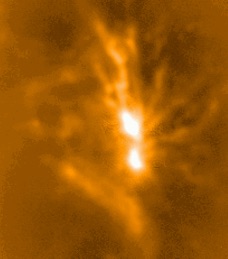
Why do Protostars give off infrared and radio light anyways?
The gas in interstellar space that ultimately collapses to form stars is very cold. In some cases only about 10 degrees Kelvin (10 degrees above absolute zero!). Therefore, the gas itself is very low energy and is unable to radiate high energy light. The figure below displays what is known as “the Planck Function” which describes how objects of various temperatures can emit light.

There is also another, very important way that interstellar gas can emit light at radio and infrared wavelengths. One of the great successes of modern science is the ability to identify atoms and molecules without ever having to be in direct contact with them. This is possible because atoms and molecules emit light (called “spectral lines”) at only very specific wavelengths. In addition, the particular wavelengths emitted are specific to the atom or molecule in question and to no other. In other words, no two atoms or molecules emit light at the same wavelengths. Thus, we can identify the atoms and molecules in a distant star or galaxy no matter how far away the object happens to be! Kind of like fingerprinting from a very long ways away!
This figure shows that objects that are hotter than about 4000 degrees Kelvin are able to emit lots of light in the visible part of the spectrum. This is why the Sun, which is a 5000 K ball of gas, glows brightly and can be easily seen by our naked eyes! The cold interstellar gas (temperatures less than 300 K), however, emits no light at all in the visible part of the electromagnetic spectrum! It does, however, emit MOST of its light in the Radio and Infrared part of the spectrum (notice that the highest part of the 300 K curve has an Infrared wavelength).

Molecules, in particular, tend to emit spectral line emission at radio and infrared frequencies. So by using radio and infrared telescopes, we can study the chemical content of the protostars and their natal environments, as well as the overall motion of the material. Is the material collapsing? Expanding? Rotating? What atoms and molecules are present at each of the stages of star formation? And how does this compare to the abundances of species like water and oxygen that are abundant on Earth and so vital to the development of life as we know it? These are only some of the questions that we try to address by studying the molecular emission from star forming regions.
The Orion Nebula seen at radio wavelengths. The molecules listed are only some of the many species seen in this rich star forming region.











